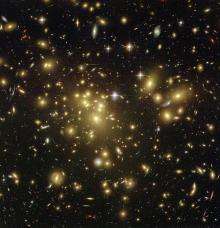February 24, 2012 report
Astrophysicist team suggests axions could explain dearth of lithium-7 in dark matter theory

(PhysOrg.com) -- In trying to understand how everything came to be as it appears today, astrophysicists have put together theories that seek to explain how events transpired from the time of the Big Bang, till now. In so doing, they have come up with some ideas that cannot yet be proven. One is the concept of dark matter, which is what many researchers believe makes up to eighty percent of all matter in the universe. The problem with the theory though, is that one particular isotope, lithium-7, should be more abundant if the model is to hold true.
Theorists suggest that shortly after the Big Bang, the universe was nothing but a superheated mass of protons and neutrons which over time merged to form the light gas element deuterium and isotopes of helium and lithium. Later, temperatures eventually began to cool and electrons began to connect with nuclei causing photons to stop discharging, which led eventually to the formation of all the other elements that we know today. Scientists have come to create such theories based on current cosmic microwave background (CMB) measurements. The problem though, is that models that try to recreate the whole process wind up having far more lithium-7 in them than actually exists.
This is where a team from the University of Florida comes in. They suggest that a low mass boson called an axion could account for the discrepancy. They say if such a particle does truly exist, as some suspect, it could, if cold enough, it could form a cosmological Bose-Einstein condensate, which could have interacted with those very early photons and cooled them down. And if that happened, the amount of lithium-7 produced would have been much less than has been calculated, enough so that it would align with what is found to actually exist today. This, they say, would solve the whole lithium-7 problem. They have published the results of their work in Physical Review Letters.
Of course, it’s not as simple as that, because if less lithium-7 developed, more of something else would have had to come about, and in the model, that would have to be deuterium and more neutrino types, which thus far doesn’t seem to be the case.
But that could change as the European Space Agency is currently working on a highly sophisticated method of measuring neutrinos, and if they find more, this new research could turn out to be a turning point in proving that axions are real which would give more credence to the models that seek to explain how everything around us came to be.
More information: Axion Dark Matter and Cosmological Parameters, Phys. Rev. Lett. 108, 061304 (2012). DOI:10.1103/PhysRevLett.108.061304
Abstract
We observe that photon cooling after big bang nucleosynthesis but before recombination can remove the conflict between the observed and theoretically predicted value of the primordial abundance of 7Li. Such cooling is ordinarily difficult to achieve. However, the recent realization that dark matter axions form a Bose-Einstein condensate provides a possible mechanism because the much colder axions may reach thermal contact with the photons. This proposal predicts a high effective number of neutrinos as measured by the cosmic microwave anisotropy spectrum.
Physics Synopsis available.
© 2011 PhysOrg.com




















